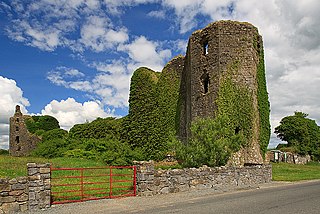
Earl of Kingston is a title in the Peerage of Ireland. It was created in 1768 for Edward King, 1st Viscount Kingston. The Earl holds the subsidiary titles Baron Kingston, of Rockingham in the County of Roscommon, Viscount Kingston, of Kingsborough in the County of Sligo, Baron Erris, of Boyle in the County of Roscommon, and Viscount Lorton, of Boyle in the County of Roscommon, also in the Peerage of Ireland. He is also a baronet in the Baronetage of Ireland. Between 1821 and 1869 the earls also held the title Baron Kingston, of Mitchelstown in the County of Cork, in the Peerage of the United Kingdom.

Baron Sandford is a title that has been created twice, both times in the Peerage of the United Kingdom. The first creation came in 1891 when Sir Francis Sandford, a civil servant who played an important role in the implementation of the Elementary Education Act 1870, was made Baron Sandford, of Sandford in the County of Salop. He was the son of Sir Daniel Sandford, politician and Greek scholar, the grandson of the Right Reverend Daniel Sandford, Bishop of Edinburgh, the brother of Daniel Sandford, Bishop of Tasmania, and the first cousin of the Right Reverend Charles Sandford, Bishop of Gibraltar. He was childless and the title became extinct on his death in 1893.

Frenchpark, historically known as Dungar, is a village in County Roscommon, Ireland on the N5 national primary road. It was the home of Douglas Hyde, the first President of Ireland.
Nathaniel Clements was an Irish politician and financial figure, important in the political and financial administration of Ireland in the mid-18th century.
Baron Mount Sandford, of Castlerea in the County of Roscommon, was a title in the Peerage of Ireland. It was created on 31 July 1800 for Henry Sandford, with remainder in default of male issue of his own, to his brothers William Sandford and George Sandford, and the heirs male of their bodies. He had previously represented Roscommon in the Irish House of Commons. He was succeeded according to the special remainder by his nephew, the second Baron. He was the son of William Sandford. Lord Mount Sandford was kicked to death during a brawl at Windsor on his way to the Ascot races in 1828. He was succeeded by his uncle, the third Baron. He had previously represented County Roscommon and the borough of Roscommon in the Irish Parliament. The barony became extinct on his death on 25 September 1846. The Sandford family descended from Theophilus Sandford, who was granted lands at Castlerea in County Roscommon in reward for his services during the English Civil War. His grandson Robert Sandford was a member of the Irish Parliament for County Roscommon. The latter's eldest son, Henry Sandford, also represented this constituency in the Irish Parliament. Henry Sandford eldest son was the first Baron Mount Sandford.
Henry Brooke may refer to:
John Devereux may refer to:
This is a list of people with the name St. George. For saints called George and other uses, see Saint George (disambiguation).

Strokestown Park House is a Palladian style Georgian house in Strokestown, County Roscommon, Ireland, set on about 300 acres (120 ha).

Edward Michael Pakenham, 2nd Baron Longford was an Anglo-Irish naval officer, peer and landowner.
The High Sheriff of Roscommon was the British Crown's judicial representative in County Roscommon, Ireland from 1575 until 1922, when the office was abolished in the new Free State and replaced by the office of Roscommon County Sheriff. The sheriff had judicial, electoral, ceremonial and administrative functions and executed High Court Writs. In 1908, an Order in Council made the Lord-Lieutenant the Sovereign's prime representative in a county and reduced the High Sheriff's precedence. However the sheriff retained his responsibilities for the preservation of law and order in the county. The usual procedure for appointing the sheriff from 1660 onwards was that three persons were nominated at the beginning of each year from the county and the Lord Lieutenant then appointed his choice as High Sheriff for the remainder of the year. Often the other nominees were appointed as under-sheriffs. Sometimes a sheriff did not fulfil his entire term through death or other event and another sheriff was then appointed for the remainder of the year. The dates given hereunder are the dates of appointment. All addresses are in County Roscommon unless stated otherwise.
Henry Moore Sandford, 1st Baron Mount Sandford, was an Irish landowner and politician.
George Sandford, 3rd Baron Mount Sandford, was an Irish politician.
Robert Sandford may refer to:
Sandys is a surname of Old English origin. It is an older spelling of Sands, and is now usually pronounced as such.

Castlereagh is a barony in County Roscommon, Ireland. It is named after the town of Castlerea within the barony. Its area in 1891 was 82,081 acres (33,217 ha).
Sir Henry Talbot of Templeogue, County Dublin, and Mount Talbot, County Roscommon, was a seventeenth-century Irish Catholic landowner, who was elected MP for Newcastle Borough in 1640. His marriage made him a brother-in-law of Richard Talbot, 1st Earl of Tyrconnell.
Henry Pakenham was Dean of St Patrick's Cathedral, Dublin from 1843 until his death.
James Agar was an Irish politician. He was a litigious and hot-tempered man, whose bitter feud with a rival political faction led to his being killed in a duel. He was the father of the first and last Baron Callan.
The Rt. Hon. Silver Oliver PC was an Irish landowner and Privy Counsellor politician who owned Castle Oliver in County Limerick, Ireland.





